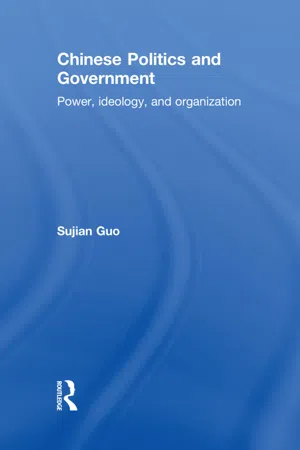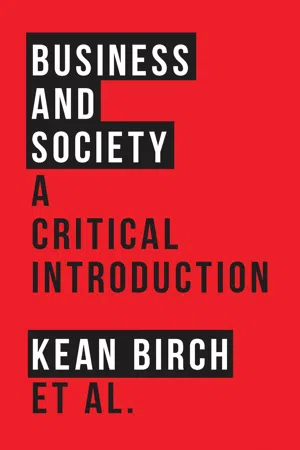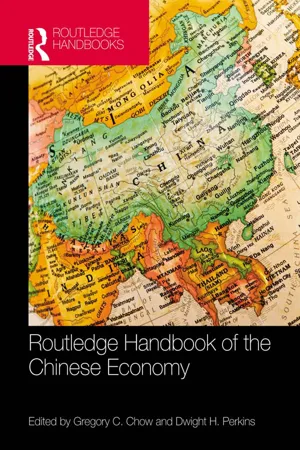Economics
Command Economy
A command economy is a system in which the government makes all decisions about production, distribution, and pricing of goods and services. This centralized approach contrasts with a market economy, where these decisions are made by individuals and businesses. In a command economy, the government typically owns the means of production and sets production targets and resource allocation.
Written by Perlego with AI-assistance
Related key terms
4 Key excerpts on "Command Economy"
- eBook - ePub
Chinese Politics and Government
Power, Ideology and Organization
- Sujian Guo(Author)
- 2012(Publication Date)
- Routledge(Publisher)
In a free market economy, it is private citizens or private firms who own the private property or the means of production, and therefore control their own factors of production, determine what should be produced, and have the right to the residual income from their asset. It is the “invisible hand” of market forces that establishes the exchange value while the state plays a passive role allowing private actors to operate freely in the market and prevent private actors from doing violence to each other or violating the rights of others. In a planned Command Economy, it is the state that owns the means of production, controls the production, distribution, and exchange, and determines what to produce and who will receive what products at what levels according to the state plan. It is the state that sets the official values for all exchanges of goods and services. 4 The centrally planned Command Economy as an economic system is also theoretically conceptualized as “state socialism” in contrast to market capitalism. 5 State socialism as an economic system State socialism refers to the economic system in communist states, such as the Soviet Union, formerly communist states in Eastern Europe, China, Vietnam, North Korea, and Cuba - eBook - ePub
Business and Society
A Critical Introduction
- Kean Birch, Mark Peacock, Richard Wellen, Caroline Hossein, Sonya Scott, Alberto Salazar(Authors)
- 2017(Publication Date)
- Zed Books(Publisher)
A second difference between a market economy and a centrally planned one is that, in the latter, people are instructed what to do to a far greater degree. For this reason, centrally planned economies are sometimes called command economies : the government commands people to do certain things in accordance with its central plan (e.g. what to produce, how much, which production techniques to use, how much to pay the workers etc.). In a market economy, by contrast, people are free to decide what to do. If a group of people decides to form a business which manufactures USB sticks, it is not because the government instructs them to do so. In a market economy, people are free to decide what to produce or which career to pursue. If some people decide to produce USB sticks, they themselves determine the number of USB sticks they produce per year, at what price they are to be sold, how much to pay the workforce, from where the materials for making USB sticks are sourced etc. But if people are free to decide what to do in a market economy, how can we be assured that the right number of USB sticks is produced and at what price? This brings us to the issue of the market’s ability to ‘self-correct’. Markets, order and self-correction In what follows, we concentrate on one market, namely the labour market, and we ask how order is produced in this market and how the labour market might be said to correct disorder. We start with what Karl Marx calls the social division of labour. This term refers to the distribution of producers to different branches of production in society. Let us take a snapshot of the social division of labour in a country like Canada in the year 2014. In 2014, about 18 million people had jobs in Canada. Of these, nearly 4 million worked in manufacturing, 370,000 in natural resources, 1.3 million in construction and 1.1 million in catering (Statistics Canada 2015a) - eBook - ePub
Democratic Community
Nomos XXXV
- John W. Chapman, Ian Shapiro(Authors)
- 1995(Publication Date)
- NYU Press(Publisher)
2Needless to say, the world is far more complex than these categories might suggest.3 But they will do, I think, for the task at hand.2. DEMOCRACY AND SOCIALIST COMMAND ECONOMIES
It has often been observed that no democratic country has ever had a socialist Command Economy, and no country with a socialist Command Economy has had a democratic political system. How can we account for this striking fact? There are, I believe, two reasons: in one, the causal arrow runs from the political to the economic; in the other it is reversed.In the first case, socialist command economies have only been introduced by leaders who have adhered to an ideology hostile to democratic institutions, that is, Leninism. In practice, the fundamental tenets of Leninism were, if adhered to by the rulers of a state, sufficient to prevent democratic institutions from developing, and sufficient to justify and encourage their destruction wherever they existed within reach of the Leninist rulers. These antidemocratic tenets include the Leninist conception of the vanguard party with its privileged access to knowledge of the laws of history; the belief that under the guidance of the vanguard party not only the proletariat but all of humankind would be liberated; the consequent denial of legitimacy to and the suppression of all oppositions; the contempt for “bourgeois democracy” as a mere mask for bourgeois domination; and the dynamics of one party rule. Armed with their faith in these beliefs and practices, Leninist rulers did not require a Command Economy in order to destroy democratic institutions or to prevent them from developing: Their control of the state and its potential for coercion and repression would have been sufficient, as dictatorial regimes have amply demonstrated in noncommunist countries that have retained (or as in Chile under Pinochet even strengthened) market economies. - eBook - ePub
- Gregory C. Chow, Dwight H. Perkins(Authors)
- 2014(Publication Date)
- Routledge(Publisher)
3THE CENTRALLY PLANNED Command Economy (1949–84) Dwight H. PerkinsIntroduction
When the Chinese Communist Party took over the government of China in 1949, it set out to fundamentally change the way the economy was organized. Initially the main task was to control the hyperinflation of the pre-1949 years and this was followed by the state takeover of ownership of most of industry and commerce. This in turn was followed by the replacement of household agriculture with agricultural producer cooperatives, a process largely accomplished in the winter of 1955–6. With the state takeover of industry and commerce, the government then moved to replace the production and distribution system, which up to that point had largely been governed by market forces, with a system of central planning where the government decided what would be produced, who would produce it, and from whom enterprises would receive the inputs required for this production.This system of government control of the production and allocation of industrial products was patterned on the system then in place in the Soviet Union. The decisions as to what to produce with what inputs was made by a central planning agency that in China was called the State Planning Commission (SPC). The SPC drew up output targets for each industry together with targets indicating which inputs in what quantity would be used to produce those products. These output and input targets were then broken down into comparable targets for individual enterprises. The managers of these enterprises were then expected to carry out their part of the plan as spelled out by these SPC targets. There were a variety of implementation measures designed to ensure that the managers would do precisely that and these will be described below. Industrial inputs and output were not bought and sold on the market – they were allocated administratively by a government agency that completely replaced the market in most cases.
Learn about this page
Index pages curate the most relevant extracts from our library of academic textbooks. They’ve been created using an in-house natural language model (NLM), each adding context and meaning to key research topics.



